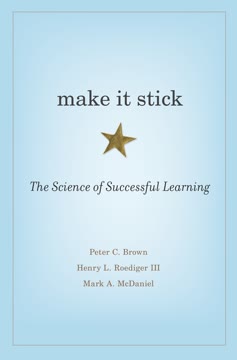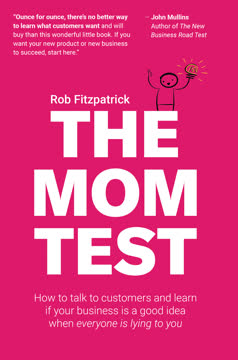Key Takeaways
1. Start with a niche audience and solve their critical problem
Find the most critical problem in a market and solve it well.
Identify your niche. Look for a specific subset of a larger population that shares common characteristics, problems, and goals. This homogeneity allows for targeted marketing and product development. Ensure your niche is large enough to sustain your business but small enough to avoid intense competition.
Solve a critical problem. Focus on addressing a pain point that:
- Is frequent and recurring
- Wastes time or money
- Cannot be ignored or delegated
- Takes up significant time to solve
- Forces people to create their own systems
By solving a critical problem, you create a product that customers genuinely need and are willing to pay for. This approach sets the foundation for a sustainable bootstrapped business.
2. Build a minimum viable product (MVP) that delivers value quickly
If you're not embarrassed by the first version of your product, you have launched too late.
Focus on core functionality. Your MVP should contain only the essential features needed to solve your customers' critical problem. Avoid feature creep and perfectionism. The goal is to get your product in front of customers as quickly as possible to gather feedback and validate your solution.
Release early and often. Implement a continuous integration and deployment system that allows for quick, safe releases. This enables you to:
- Rapidly iterate based on customer feedback
- Fix bugs and issues promptly
- Gradually improve your product over time
Remember, your MVP is not meant to be perfect. It's a starting point that allows you to learn and adapt based on real-world usage and customer needs.
3. Focus on customer retention and building long-term relationships
Retaining a customer is easier than finding a new one.
Prioritize customer success. Implement strategies to ensure your customers derive maximum value from your product:
- Provide excellent onboarding and support
- Regularly communicate product updates and improvements
- Offer resources and education to help customers achieve their goals
Implement retention strategies. Focus on keeping existing customers happy and engaged:
- Offer annual subscription plans for better commitment and cash flow
- Implement a referral system to incentivize word-of-mouth marketing
- Regularly seek feedback and act on customer suggestions
- Provide personalized experiences and demonstrate the value they're receiving
By prioritizing retention, you create a stable revenue base and reduce the pressure to constantly acquire new customers.
4. Implement systems and processes for scalable growth
Forget goals, create systems: Foundations of a sustainable business.
Automate and document. Create standard operating procedures (SOPs) for all key business processes. This documentation serves multiple purposes:
- Enables consistent execution of tasks
- Facilitates easy onboarding of new team members
- Prepares the business for potential sale or transition
Build a repeatable, reliable, and resilient system. Focus on creating processes that can:
- Handle increased volume without significantly increasing costs
- Adapt to changing market conditions and customer needs
- Recover quickly from disruptions or setbacks
Implementing robust systems and processes allows your business to grow efficiently and reduces dependence on any single individual, including yourself.
5. Create a strong brand identity and foster a loyal community
A tribe is a group of people that are connected to each other, an idea, and a leader.
Develop a clear brand voice and positioning. Articulate your unique value proposition and communicate it consistently across all channels. This helps differentiate your product in the market and attracts customers who resonate with your mission.
Build a tribe around your brand. Foster a community of loyal customers and advocates:
- Facilitate communication and exchange between community members
- Produce and share valuable content relevant to your niche
- Engage authentically in industry conversations and events
- Empower your customers to become brand ambassadors
A strong brand and loyal community create a competitive advantage that's difficult for others to replicate.
6. Continuously validate and improve your product and business model
Continuous Validation is the practice of assuming that every product is an iteration of trying to solve a shape-shifting problem.
Regularly reassess market fit. Conduct periodic checks to ensure your product still solves a critical problem for your target audience:
- Monitor industry trends and changes
- Seek customer feedback on evolving needs and pain points
- Analyze usage data to identify areas for improvement
Iterate on your business model. Be prepared to adapt your pricing, features, or target market as your business grows:
- Experiment with different pricing models and tiers
- Consider expanding into adjacent markets or customer segments
- Explore partnerships or integrations to add value
Continuous validation helps you stay ahead of market changes and maintain product-market fit over time.
7. Prepare your business for a potential exit from day one
A sellable business is focused, can run without you, and is independent.
Build a sellable business. Even if you don't plan to sell, structuring your business as if you might exit:
- Creates a more valuable and efficient operation
- Reduces dependency on you as the founder
- Provides options for future growth or transition
Focus on key metrics and documentation. Maintain clear financial records, customer data, and operational processes. This preparation:
- Facilitates due diligence if you decide to sell
- Attracts potential buyers with a well-organized business
- Allows for smoother transition and higher valuation
By building a sellable business from the start, you create more options for yourself and increase the overall value of your company.
Last updated:
FAQ
What's Zero to Sold about?
- Guide to Bootstrapping: Zero to Sold by Arvid Kahl is a comprehensive guide on starting, running, and selling a bootstrapped business, focusing on the journey of a founder without external funding.
- Real-Life Experiences: The book draws from Kahl's personal experiences with his SaaS business, FeedbackPanda, providing a practical framework for understanding the challenges and strategies in bootstrapping.
- Focus on SaaS: While it primarily uses SaaS examples, the principles and strategies are applicable to various business types, emphasizing understanding your audience before product development.
Why should I read Zero to Sold?
- Actionable Strategies: The book offers actionable strategies for aspiring entrepreneurs, especially those interested in bootstrapping, covering topics like audience identification and product development.
- Mental Health Awareness: Kahl highlights the importance of mental health for founders, discussing the emotional challenges of entrepreneurship and encouraging self-care.
- Realistic Expectations: It sets realistic expectations about the entrepreneurial journey, highlighting both the joys and pains of building a business and encouraging readers to embrace the process.
What are the key takeaways of Zero to Sold?
- Four Stages of Business: Kahl outlines the stages of a bootstrapped business: Preparation, Survival, Stability, and Growth, each with unique challenges and strategies.
- Focus on Problems: Identifying and validating the critical problems of your target audience before developing a solution ensures the product addresses real needs.
- Continuous Improvement: The book stresses the need for continuous validation and improvement of both the product and business processes for long-term success.
What are the best quotes from Zero to Sold and what do they mean?
- "Strong action bias": This quote emphasizes the importance of taking action rather than overthinking, encouraging entrepreneurs to start working on their ideas.
- "Your product will never be finished": Kahl highlights that businesses are always evolving, helping founders remain flexible and responsive to market changes.
- "A business can only be as healthy as its founder": This underscores the connection between a founder's mental health and business success, reminding entrepreneurs to prioritize self-care.
What is bootstrapping as defined in Zero to Sold?
- Self-Funded Business Model: Bootstrapping involves starting and growing a business with little to no external funding, using personal savings and revenue from sales.
- Resourcefulness Required: Founders must be resourceful and innovative, solving problems and creating value without significant financial backing.
- Long-Term Focus: Bootstrapping encourages sustainable growth rather than rapid scaling, leading to more stable and profitable businesses.
What are the four stages of a bootstrapped business in Zero to Sold?
- Preparation Stage: Focuses on finding your audience, validating their problems, and developing a solution, ending when you begin selling your product.
- Survival Stage: Involves finding a repeatable way to generate revenue, refining the product, and building customer relationship processes.
- Stability Stage: Achieving steady revenue and offering a mature product, often involving hiring help and building long-lasting customer relationships.
- Growth Stage: Deciding whether to continue running the business or sell it, learning to scale operations, and exploring financing or investment options.
How does Zero to Sold address mental health for founders?
- Importance of Mental Health: Kahl emphasizes mental health as crucial for entrepreneurs, as business stresses can lead to burnout and anxiety.
- Realistic Expectations: Discusses the emotional ups and downs of entrepreneurship, helping readers understand that struggles are normal and alleviating feelings of isolation.
- Practical Strategies: Offers strategies for managing stress and maintaining a healthy work-life balance, advocating for self-care and supportive networks.
What is the significance of audience and problem validation in Zero to Sold?
- Identifying the Right Audience: Understanding your target audience is essential for building a successful business, involving research into their needs and pain points.
- Validating Problems: Founders should validate that the problems they aim to solve are significant and shared by their audience, ensuring market fit.
- Iterative Process: Requires ongoing conversations with potential customers to refine understanding and create a product that resonates with users.
How does Zero to Sold suggest handling feature requests?
- Saying No: Emphasizes the importance of saying no to non-essential features to maintain focus and simplicity, preventing feature bloat.
- Prioritization Frameworks: Introduces frameworks to assess which features provide the most value, aiding in informed decision-making.
- Customer-Centric Approach: Advises ensuring new features align with the business's vision and goals, balancing customer feedback with sustainable growth.
What are some common pitfalls for bootstrapped founders mentioned in Zero to Sold?
- Perfectionism: Warns against perfectionism, which can delay product launches and hinder progress, advocating for "good enough" rather than perfect.
- Ignoring Mental Health: Many founders neglect mental health, leading to burnout; Kahl encourages prioritizing self-care and seeking support.
- Overcomplicating Processes: Founders may create overly complex systems, hindering efficiency; simplicity and streamlined processes are essential.
How can I apply the lessons from Zero to Sold to my own business?
- Start with Research: Thoroughly research your target audience and validate their problems, guiding product development and marketing strategies.
- Embrace Iteration: Be prepared to iterate on your product based on feedback and market conditions, as flexibility is key to success.
- Focus on Mental Health: Prioritize mental well-being, build a support network, and practice self-care to maintain a healthy work-life balance.
What is the AAAH! framework mentioned in Zero to Sold?
- Awareness: Recognize that change is happening, especially during economic downturns, and accept the reality of the business environment.
- Anticipation: Think about the implications of market changes and prepare for them, anticipating shifts in customer behavior.
- Adaptation: Implement short-term and long-term adaptations to the business model, as flexibility is crucial for survival and growth.
Review Summary
Zero to Sold receives mostly positive reviews, with readers praising its practical advice for bootstrapping SaaS businesses. Many find it comprehensive, covering everything from idea validation to exit strategies. Entrepreneurs and tech founders particularly appreciate the author's experience-based insights. Some criticize its focus on software businesses and occasional technical details. While a few readers find it dry or repetitive in parts, most consider it a valuable resource for aspiring and current SaaS founders, especially those with technical backgrounds.
Similar Books










Download PDF
Download EPUB
.epub digital book format is ideal for reading ebooks on phones, tablets, and e-readers.




